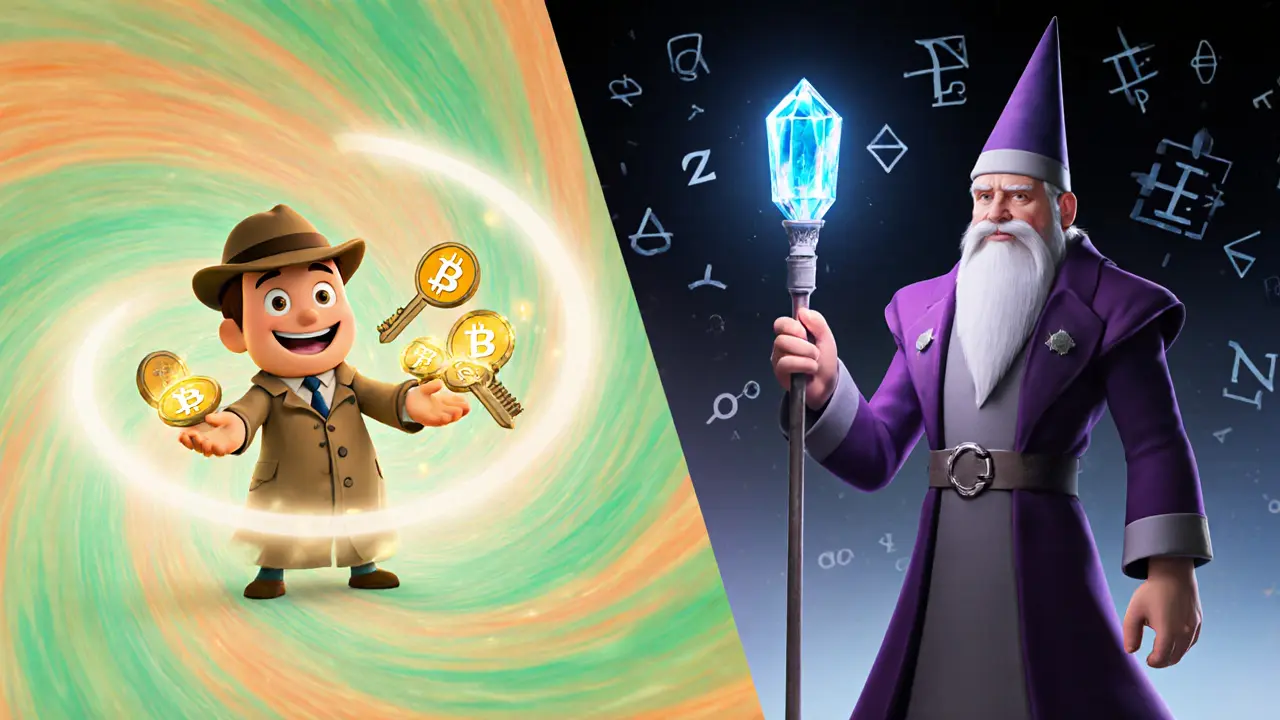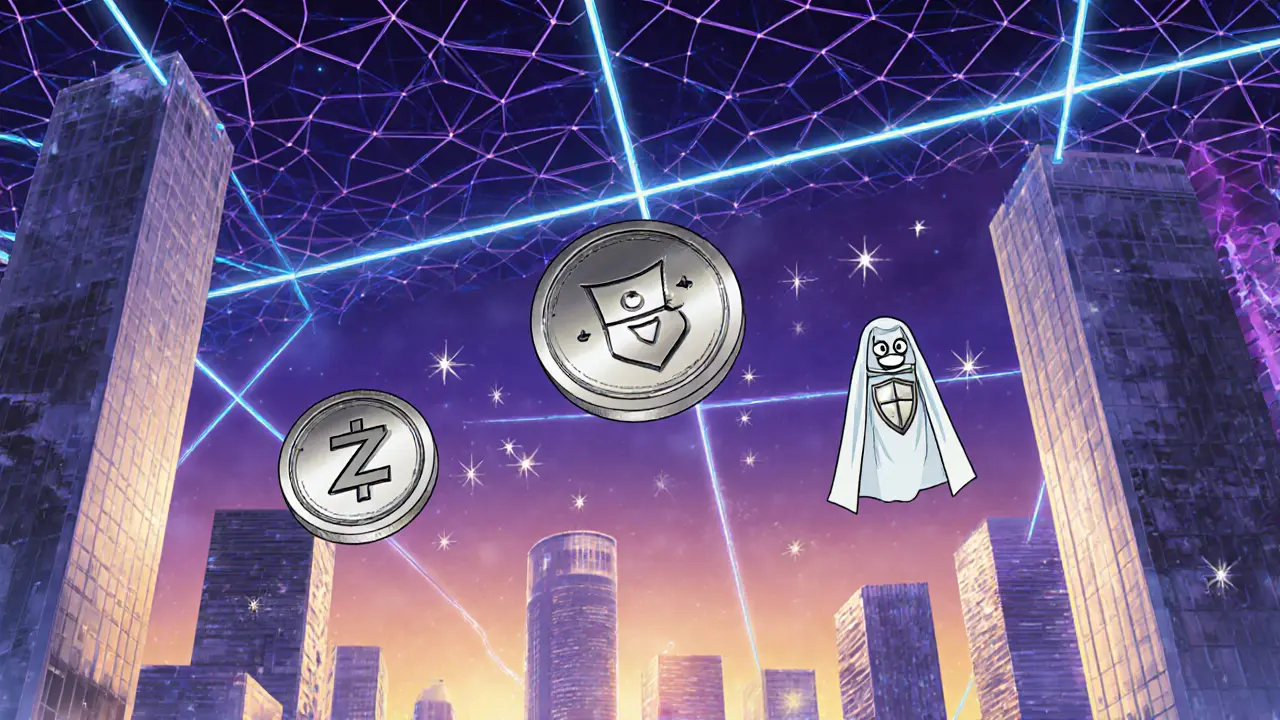Privacy Coin Performance Calculator
Choose Your Comparison Metric
Select which performance metric you want to compare between ring signatures and zk-SNARKs.
Ring Signatures (Monero)
zk-SNARKs (Zcash)
Performance Comparison
When you hear privacy coin technology, you probably picture untraceable crypto transfers that leave no digital breadcrumbs. Two cryptographic tricks-ring signatures and zk‑SNARKs-make that vision possible, but they do it in very different ways. This guide breaks down how each method works, where they shine, and what trade‑offs you should expect if you’re building or using a privacy‑focused blockchain.
What Exactly Is a Privacy Coin?
Privacy coin is a type of cryptocurrency designed to conceal the sender, receiver, and transaction amount while still allowing the network to verify that no double‑spending occurs. The goal is to solve the blockchain privacy paradox: transparency for consensus, anonymity for participants. The most prominent examples today are Monero and Zcash, each relying on a distinct cryptographic core.
Ring Signatures: Hiding the Sender in a Crowd
Ring signatures were first described in academic papers in the early 2000s and became practical with Monero’s 2014 launch. The idea is simple: when you sign a transaction, your signature is blended with a set of decoy signatures taken from previous blockchain outputs. To an outside observer, the signature could belong to any member of that “ring.”
Ring signatures combine a real private key with a list of public keys from unrelated transactions, producing a single cryptographic proof that reveals nothing about which key actually signed. Monero augments this core with Stealth Addresses (one‑time recipient addresses) and Ring Confidential Transactions (RingCT), which hide the transferred amount. Together they create a multi‑layered privacy stack.
From a developer’s perspective, building a ring‑signature system requires:
- Choosing an appropriate ring size (the number of decoys). Monero moved from a minimum of 11 to 16 signatures in its 2023 "Oxygen Orion" fork, boosting anonymity at the cost of larger transaction data.
- Fetching random past outputs to serve as decoys, which adds latency and network bandwidth usage.
- Ensuring that each transaction includes a mandatory RingCT proof, so amounts stay hidden.
zk‑SNARKs: Proving Validity Without Revealing Data
Zero‑Knowledge Succinct Non‑Interactive Argument of Knowledge, or zk‑SNARKs, entered the crypto scene with Zcash’s 2016 mainnet. Unlike ring signatures, zk‑SNARKs let you prove that a transaction obeys all consensus rules-no double‑spend, correct balances-while encrypting every field of the transaction.
zk‑SNARKs work in three steps: the prover creates a short cryptographic proof from the hidden data, the verifier checks the proof with a public verification key, and the proof’s size stays constant (typically 100‑400bytes) regardless of transaction complexity. Early Zcash deployments required a "trusted setup" ceremony to generate public parameters; if any participant kept a secret key, the system could be compromised. The recent "Halo 2" upgrade (part of NU5) eliminates the trusted setup, making the system more trustless.
Implementation demands are steeper than for ring signatures:
- Developers must understand elliptic‑curve pairings, quadratic arithmetic programs, and the specifics of the proving system (e.g., Groth16, Halo 2).
- Proof generation can take 30‑40 seconds on a consumer laptop, though optimised libraries like Circom and SnarkJS have cut that time by about a third since 2021.
- Wallets need to manage two address types: transparent (t‑addr) and shielded (z‑addr), which can confuse users.

Performance & Scalability: Size, Speed, and Throughput
Both technologies add overhead, but in different dimensions. Ring signatures inflate transaction size because each signature carries dozens of decoys. Studies from Chainalysis (2023) estimate a 15‑20× increase compared to transparent transactions, pushing Monero’s average transaction size to roughly 12‑15KB.
zk‑SNARKs keep proof size tiny (≈200bytes) but proof generation is CPU‑intensive. Verification is fast-about 3‑6ms on a typical PC-so network nodes can handle shielded transactions with little latency. However, Zcash’s shielded transaction rate caps around 1.2TPS on standard hardware, far below Bitcoin’s 7TPS or Ethereum’s 15‑30TPS (depending on congestion).
In practice, Monero can process about 1,000 transactions per block (2‑minute block time), while Zcash’s shielded path slows down to roughly 300 shielded tx per block. The trade‑off is clear: ring signatures favour higher throughput but larger on‑chain data; zk‑SNARKs prioritise compact privacy at the expense of proof‑generation time.
Security, Trust, and Potential Attack Vectors
Ring signatures rely on the assumption that an adversary cannot guess which ring member signed. If a ring is too small or decoy selection is biased, statistical analysis can prune the ring and expose the real signer. Monero’s move to larger mandatory ring sizes is a direct response to this risk.
zk‑SNARKs’ historic weak point was the trusted setup. If any participant retained the secret toxicity key, they could create counterfeit proofs, effectively minting coins. Halo 2 removes that concern, but the mathematics remain complex, raising the bar for audits and formal verification. Moreover, side‑channel attacks on proof generation have surfaced in research labs, though practical exploits on live networks remain scarce.
Both systems have faced deanonymisation attempts. Dr. Sarah Jamie Lewis highlighted that multi‑dimensional metadata-timing, amount patterns, network‑level observations-can still leak information, especially when users repeatedly reuse addresses or send low‑value amounts that stand out.
Real‑World Use Cases and Ecosystem Support
Monero’s ring‑signature model powers a straightforward “privacy by default” wallet experience. Users click “send,” and the software automatically selects decoys, applies RingCT, and broadcasts a transaction that looks like any other Monero tx. This simplicity fuels its strong community adoption: over 85,000 Telegram members, 327 GitHub contributors, and a 78% satisfaction rating in a 2023 Reddit poll.
Zcash’s zk‑SNARKs enable selective disclosure. The "zk‑Reveals" feature lets a user prove that a transaction complies with AML checks without revealing the underlying address or amount. Panther Protocol leveraged this to process $47million of compliant DeFi trades in Q22023, showing how zk‑SNARKs can bridge privacy and regulation.
Both coins face regulatory headwinds. The EU’s MiCA rules (effective 2024) force service providers to collect KYC data, which clashes with the fully private nature of shielded Zcash transactions. Monero users often resort to peer‑to‑peer exchanges or privacy‑preserving mixers to stay off regulated platforms.

Future Directions: Hybrid and Quantum‑Resistant Designs
The industry is converging on hybrid solutions that blend ring signatures and zk‑SNARKs. Projects like Panther Protocol already combine zk‑SNARKs for compliance with layer‑2 mixers for extra anonymity. Research labs in Monero and Zcash are also experimenting with quantum‑resistant primitives-ring signatures built on lattice‑based assumptions and zk‑SNARKs using Ring‑LWE maths-aiming for a post‑quantum privacy stack by 2025.
Developers should keep an eye on the upcoming "Oxygen Orion" fork for Monero, which will increase minimum ring size to 16, and Zcash’s NU5 rollout, which introduces the Orchard protocol powered by Halo 2. Both upgrades illustrate a trend: improving privacy guarantees while reducing the trust assumptions that once plagued each technology.
| Aspect | Ring Signatures (Monero) | zk‑SNARKs (Zcash) |
|---|---|---|
| Privacy Scope | Sender anonymity; amounts hidden via RingCT | Sender, receiver, amount all hidden |
| Proof Size | ~12‑15KB per tx (incl. decoys) | ~200B per proof (constant) |
| Generation Time | ~0.5‑1s (ring selection + signing) | 30‑40s on consumer laptop (pre‑Halo 2 ~60s) |
| Verification Time | ~1‑2ms (standard signature check) | 3‑6ms (SNARK verification) |
| Trusted Setup | None required | Historically required; Halo 2 removed requirement |
| Scalability | Higher TPS, larger blockchain growth | Lower TPS, minimal on‑chain data growth |
| Developer Learning Curve | 80‑100hrs cryptography basics | 120‑150hrs plus pairing & QAP knowledge |
Choosing the Right Tool for Your Project
If you need fast, high‑throughput private payments with a low barrier to entry, ring signatures are a pragmatic choice. They work well for consumer wallets and decentralized applications that value speed over absolute secrecy.
If your use case demands “full‑circuit” privacy-perhaps regulated DeFi where you must prove compliance without showing details-zk‑SNARKs provide a stronger guarantee, especially now that trusted setups are no longer a stumbling block.
Many developers opt for a layered approach: use ring signatures for everyday low‑value transfers, and fall back to zk‑SNARK‑based shielded pools for high‑value or compliance‑sensitive moves. This hybrid model captures the best of both worlds while hedging against the regulatory and performance limitations of each technique.
Quick Checklist for Implementers
- Define privacy goals: sender anonymity only vs full transaction concealment.
- Assess performance impact on your target device (mobile vs desktop).
- Choose ring size (Monero) or proof system (Zcash) that matches your throughput needs.
- Plan for user experience: address management, backup/recovery, and potential error states.
- Stay updated on protocol upgrades (e.g., Monero’s Oxygen Orion, Zcash’s Halo 2).
Frequently Asked Questions
What is the main difference between ring signatures and zk‑SNARKs?
Ring signatures hide the sender by mixing the real signature with decoys, while zk‑SNARKs hide the sender, receiver, and amount by generating a succinct proof that the transaction is valid without revealing any details.
Do I need a trusted setup to use zk‑SNARKs?
Older implementations like Zcash’s original Sapling required a trusted setup ceremony. The newer Halo 2 system, introduced in Zcash’s NU5 upgrade, eliminates that requirement, so modern zk‑SNARKs can be deployed trustlessly.
Which technology offers faster transaction confirmation?
Ring‑signature‑based coins like Monero typically confirm faster because signing is quicker and transaction sizes, while larger, fit within the block limits. zk‑SNARK proof generation can take tens of seconds on consumer hardware, slowing down the user experience.
Can I use both technologies together?
Yes. Some projects combine ring signatures for everyday payments and zk‑SNARK‑based shielded pools for high‑value or compliance‑heavy transfers, creating a hybrid privacy model.
How do regulatory pressures affect privacy coins?
Regulators in the EU, Japan, and South Korea view fully private coins with suspicion, leading to exchange bans and KYC mandates. Technologies like zk‑SNARKs that enable selective disclosure are gaining interest because they can satisfy compliance without sacrificing user anonymity.



14 Comments
Steve Cabe
Ring signatures are a triumph of decentralized engineering, proving that the community can protect its own financial sovereignty without bowing to external surveillance. By mixing decoys, Monero throws off any state actor that tries to trace funds, which aligns with the principle of economic self‑determination. The trade‑off in transaction size is a small price to pay for preserving liberty in the digital age.
shirley morales
Privacy coins embody the ethical pinnacle of financial autonomy they reject the corrupting influence of centralized oversight and demand a higher moral standard from users.
Mandy Hawks
When we contemplate the nature of secrecy, we realize that anonymity is not merely a shield against surveillance but a reflection of our desire for personal agency. Ring signatures and zk‑SNARKs each articulate a different philosophy: one hides the actor among many, the other conceals the entire narrative. Both approaches invite us to question how much of our identity we are willing to surrender for the sake of communal trust.
Millsaps Crista
Great overview! If you’re building a new privacy layer, start by testing ring sizes on a testnet-seeing the latency firsthand will guide your design choices. Don’t forget to benchmark zk‑SNARK proof generation with the latest Halo 2 libraries; the performance gains are worth the extra setup effort.
Wayne Sternberger
Dear developer, I must emphasise the importance of careful key management when implementing RingCT; a single slip can compromize the entire transaction. Moreover, the documentation should definitely include examples of decoy selection to avoid common pitfalls. Please ensure you also adress the potential for wallet recovery issues, as these can be quite confusng for end‑users.
John Beaver
When integrating privacy primitives into a blockchain, the first decision point is choosing between ring signatures and zk‑SNARKs. Ring signatures, as employed by Monero, rely on a set of decoy outputs that are mixed with the real input to obfuscate the spender’s identity. The size of the ring directly influences both the anonymity set and the transaction payload, typically adding several kilobytes per additional decoy. On the other hand, zk‑SNARKs produce a constant‑size proof regardless of transaction complexity, often around two hundred bytes, which keeps the blockchain lean. However, generating that proof is computationally intensive, often taking thirty to forty seconds on a standard laptop, though recent optimisations have shaved a third off that time. Verification, by contrast, is swift for both methods: a few milliseconds for ring signatures and slightly more for zk‑SNARKs, which is negligible for node operation. From a developer’s perspective, ring signatures are simpler to implement because they do not require a trusted setup or advanced pairing‑based cryptography. Nevertheless, you must ensure that decoy selection is truly random; biased selection can reduce the effective anonymity set and expose users to statistical attacks. With zk‑SNARKs, the trusted setup was historically a point of concern, but the adoption of Halo 2 in Zcash’s NU5 upgrade eliminates that requirement, making the system more trustless. If your application demands full transaction privacy-including sender, receiver, and amount-zk‑SNARKs are currently the only technology that offers that complete coverage. Conversely, if you prioritize transaction throughput and are willing to accept larger on‑chain data, ring signatures can handle upwards of a thousand transactions per block. Regulatory environments also play a role; some jurisdictions are more tolerant of selective disclosure mechanisms like zk‑SNARKs, which can provide compliance proofs without revealing user data. In practice, many projects adopt a hybrid model: everyday low‑value transfers use ring signatures for speed, while high‑value or compliance‑sensitive moves employ zk‑SNARK‑based shielded pools. This layered approach lets you balance performance, privacy, and legal considerations without over‑engineering a single solution. Finally, stay abreast of upcoming protocol upgrades-Monero’s Oxygen Orion and Zcash’s Orchard-because they introduce optimisations that can shift the cost‑benefit analysis in your favour.
EDMOND FAILL
Interesting breakdown-wondering how the proof‑generation time for zk‑SNARKs will evolve now that Halo 2 cuts the trusted‑setup hassle.
Maria Rita
Wow, the contrast between ring signatures and zk‑SNARKs is like night and day, and it really shows how choices in crypto can change the whole game for users.
Jordann Vierii
Let’s keep the conversation alive, because understanding these tools helps us build a more inclusive and secure financial future for everyone.
Hari Chamlagai
The technical community often overlooks the fundamental truth that privacy is not a luxury but a necessity; ring signatures, while elegant, suffer from scalability issues that cannot be ignored, whereas zk‑SNARKs, despite their computational heft, provide a mathematically sound solution that aligns with the core principles of cryptographic privacy, and any developer serious about security should prioritize mastering zk‑SNARK constructions before settling for the older ring‑based models.
Jason Clark
Sure, just ignore the 30‑second proof generation and hope your users don’t notice the delay-nothing says “user‑friendly” like a cryptographic marathon.
Jim Greene
Great job on the guide! 😊
Teagan Beck
Thanks for laying out the differences so clearly.
Kim Evans
While the ethical framing is appreciated, it’s also useful to note the practical trade‑offs like transaction size and proof time. 👍